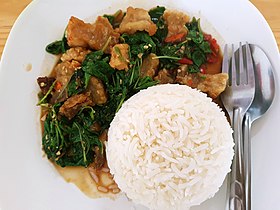Phat kaphrao
 A plate of Phat kaphrao mu krop with rice. | |
| Place of origin | Thailand |
|---|---|
| Serving temperature | Hot |
| Main ingredients | Thai holy basil, meat or seafood, garlic, Thai fish sauce, and sugar |
Phat kaphrao (Thai: ผัดกะเพรา, pronounced [pʰàt kā.pʰrāw]; transl. stir-fried holy basil), also spelled pad krapow, kaprao, is one of the most popular Thai à la carte dishes.[1]
History[]

By some accounts, phat kaphrao was included as part of Prime Minister Field Marshal Plaek Phibunsongkhram's Thai cultural mandates during WWII. Phat kaphrao, as well as pad thai, were one of the promoted dishes in local Thai food contests.[2]
Phat kaphrao was inspired by stir frying, a staple cooking process of Chinese cuisine.[3]
Some of the first four survivors of the Tham Luang cave rescue asked for phat kaphrao as their first proper meal after two weeks of being trapped inside the cave.[4]
Ingredients[]
Phat kaphrao consists of meat such as pork, chicken, beef, and seafood stir fried with Thai holy basil and garlic. It is served with rice and topped up (optional) with fried eggs or khai dao (Thai: ไข่ดาว). The main seasonings are soy sauce, Thai fish sauce, oyster sauce (optional), cane sugar, and bird's eye chili.
Over time, phat kaphrao has evolved with the addition of other ingredients such as Chinese century eggs and Thai local vegetables, namely asparagus beans, baby corns, onions, carrots, cowpeas, banana peppers, mushrooms, Chinese kales, bamboo shoots and coconut shoots. However, adding vegetables in phat kaphrao is also seen as an effort to reduce the cost of meat and increase profit margins on the part of food vendors.[5][6]
Common variants:
- Phat kaphrao kai (ผัดกะเพราไก่) – stir-fried holy basil with chicken
- Phat kaphrao mu (ผัดกะเพราหมู) – stir-fried holy basil with pork
- Phat kaphrao mu sap (ผัดกะเพราหมูสับ) – stir-fried holy basil with minced pork
- Phat kaphrao tap mu (ผัดกะเพราตับหมู) – stir-fried holy basil with pork livers
- Phat kaphrao mu krop (ผัดกะเพราหมูกรอบ) – stir-fried holy basil with crispy pork belly
- Phat kaphrao nuea (ผัดกะเพราเนื้อ) – stir-fried holy basil with beef
- Phat kaphrao nuea sap (ผัดกะเพราเนื้อสับ) – stir-fried holy basil with minced beef
- Phat kaphrao lukchin (ผัดกะเพราลูกชิ้น) – stir-fried holy basil with meatballs
- Phat kaphrao kung (ผัดกะเพรากุ้ง) – stir-fried holy basil with prawns
- Phat kaphrao pla muek (ผัดกะเพราปลาหมึก) – stir-fried holy basil with squids
- Phat kaphrao ruam mit (ผัดกะเพรารวมมิตร) – stir-fried holy basil with meat and seafood
- Phat kaphrao ruam mit thale (ผัดกะเพรารวมมิตรทะเล) – stir-fried holy basil with seafood
- Phat kaphrao khai yiao ma (ผัดกะเพราไข่เยี่ยวม้า) – stir-fried holy basil with Chinese century eggs
- Phat kaphrao het (ผัดกะเพราเห็ด) – stir-fried holy basil with mushrooms
References[]
- ^ Thuan, Willy. "Thuan, W. (n.d.). Top 10 Thai Food - Most Popular Thai Foods". Bangkok.com. Asia Web Direct.
- ^ "A Brief History of Pad Kapow".
- ^ "History of Phat Kaprao Kai". 17 August 2017.
- ^ "Cave rescue resumes in Thailand". 7 July 2018.
- ^ "A Garlicky Stir-Fry With Basil Leaves From Bangkok". 25 January 2018.
- ^ "Why Phat Kaphrao needs cowpea". 30 March 2016.
- Thai cuisine
- Thai cuisine stubs